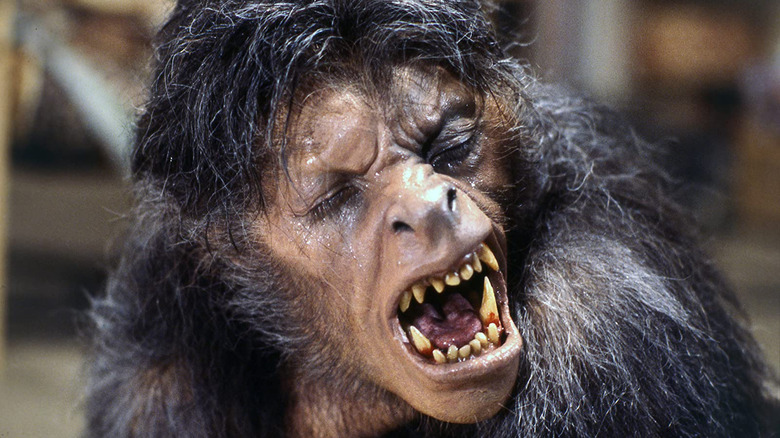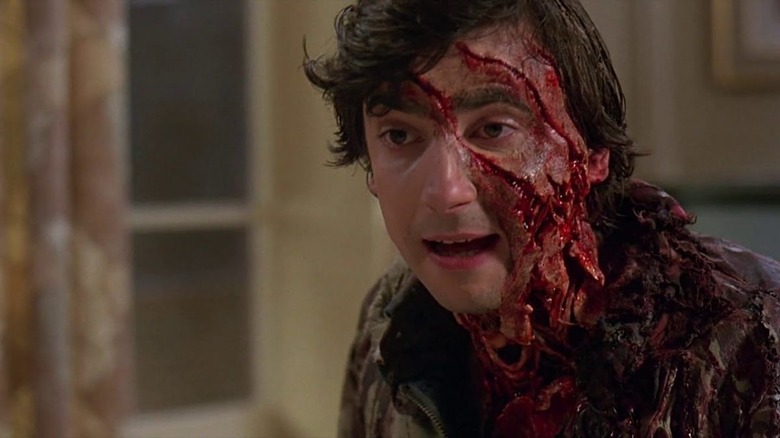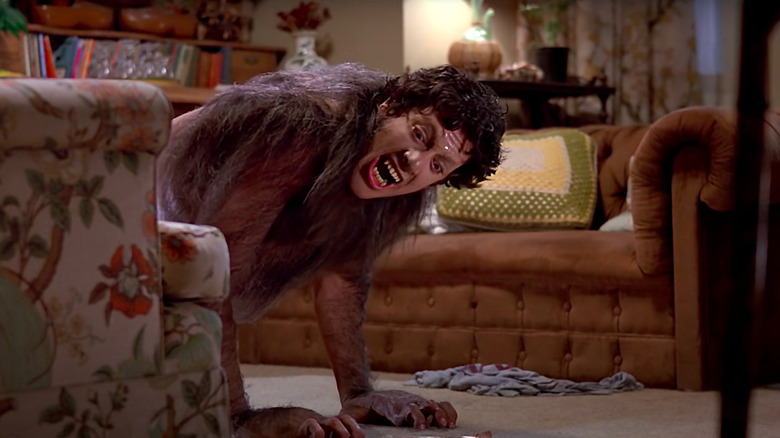The Meaning Behind Those Weird Disney Shots In An American Werewolf In London
If you pay close attention to the background of John Landis' innovative 1981 horror-comedy "An American Werewolf in London," you will notice there are numerous Disney-related items placed throughout the character Alex's (Jenny Agutter) apartment. Indeed, she has Mickey Mouse, Minnie Mouse, and Donald Duck figurines in her living room, along with a poster of Mickey Mouse adorning her hallway.
Landis carefully and deliberately moves the camera to include these Disney figures in the film's shots, often placing them alongside the main characters in such a way that it draws attention away from the latter. There's even a scene where leads David (David Naughton) and Jack (Griffin Dunne) walk through Alex's hallway and Jack stops to smell a flower, only for the camera to suddenly shift so as to bring Alex's Mickey Mouse picture into the frame. When David looks at Alex's television, there is likewise a Minnie Mouse statue coyly smiling on top of it. What's more, at one point, Jack flat-out picks up a Mickey Mouse trinket and waves its hand at David in a mocking gesture.
Is Alex merely a Disney Adult or is there actually a deeper meaning behind this motif? Thankfully, Landis has provided some insight on the matter.
The fine balance of comedy and drama
John Landis discussed these quirky Disney shots during a 2013 interview with Adam Savage. He specifically talked about the jarring yet amusing close-up of Mickey Mouse "watching" David go through his very painful and gruesome metamorphosis into a werewolf (showcasing the incredible makeup talents of Rick Baker). Mickey's painted-on smile seems to mock David as he writhes in agony while his bones crack and elongate. /Film considers it one of the most terrifying movie monster transformations of all time.
Originally, Landis wanted the agonizing sequence to be done in a single shot, but he included the Mickey Mouse cutaway because it "amused" him. Savage found the image "upsetting" because it acknowledges the idea that "[y]our house is still happening around you, but the worst thing that's ever happened to you is going on."
This brief glimpse at a grinning Disney character during such a horrifying moment epitomizes the film's razor-sharp balance between humor and horror. What makes "An American Werewolf in London" such a memorable film is that it is as hilarious as it is spine-chilling. Few other movies can oscillate from a naked David stealing a little boy's balloons at the London Zoo to a dream where bloodthirsty Nazi demons gunning down his entire family with such finesse.
Perhaps the best example of the film's duality is in the pornography theater where David's undead victims, with their decaying flesh and gaping wounds, enthusiastically try to convince him to kill himself before he can harm anyone else. Landis maintains this silly yet unsettling equilibrium up until the closing credits, which features a smash-cut to black from the film's tragic ending to a peppy version of "Blue Moon."
Choosing the fantasy
The Disney references are not just an eccentric way to interject humor into "An American Werewolf in London;" they also represent David's willful American ignorance. Film studies professor Diane Negra elaborated on this idea in her book "America First: Naming the Nation in US Film:"
"At Alex's apartment, the film surrounds him with objects that alternately reference an idealized American sense of duty and sacrifice (a 'Casablanca' poster on one wall) and a banal commercialized mass culture (the Muppets, a Mickey Mouse doll). This alternation contextualizes David's dilemma in national terms, suggesting that while honor and duty (in the form of suicide) are being urged upon him, he will abjure this option in favor of pleasure and self-indulgence (his developing romance with Alex)."
Disney offers escapism through stories of love, goodness triumphing over evil, and happiness. These stories symbolize an American idealism that many critique as unattainable and infantilizing. David naively believes that such values will come true for him, despite Jack's continual warnings about becoming a werewolf.
The Disney figures that observe David remind the audience that he chooses romantic fantasy over the realities of his grisly fate. David approaches his grave situation with trepidation and humor, believing that he can escape his tragic destiny and be with Alex. He purposely avoids killing himself despite knowing that it would save him from killing others when he transforms. He thinks the inevitable will go away if just he keeps ignoring it.
This kind of single-mindedness was what got David in trouble in the first place. David and Jack freely disregarded the locals' warnings at the Slaughtered Lamb pub to stay on the road, avoid the moors, and beware the full moon. Sure enough, when they wander into the moors, they're attacked by a vicious creature. Americans, amirite?


